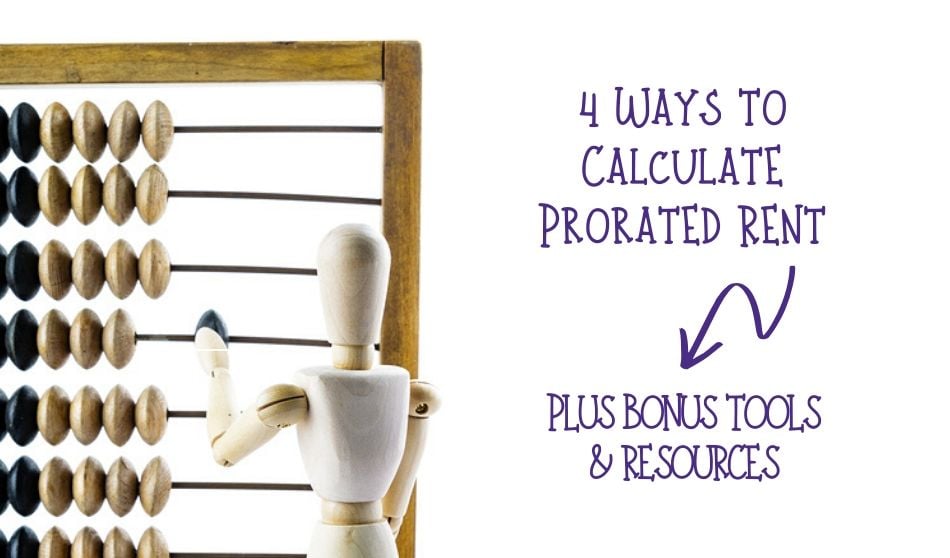
New landlords and property managers often find prorating rent challenging. Prorating rent doesn’t have to be a daunting task if you understand the formulas. Both new and seasoned professionals can benefit from the property management and real estate calculation tools and resources provided.
Prorated Rent Defined
A first-time tenant might ask a landlord what is prorated rent; not understanding the terminology. Prorate comes from the Latin pro rata which according to Merriam-Webster means: proportionately according to an exactly calculable factor. When a tenant moves in or out early, a landlord and tenant may agree to a calculated factor based on the number of actual days the unit is occupied instead of being charged a full month.
When to Prorate
Landlords and tenants alike may wonder when prorating rent is applicable. Is rent prorated when moving out, move-in, or both? Interestingly, in most states, a landlord is not required to prorate rent in either scenario. It’s important to check with your local and state regulations, but unless otherwise stated it is up to the discretion of the landlord to decide if they will prorate and which formula to use.
Some property managers choose to avoid prorating altogether by charging rent monthly based on the move-in date. This allows for staggered revenue throughout the month but may make bookkeeping and rent payment tracking difficult.
Conversely, other landlords will charge a full month’s rent if the unit is available to move-in on the 1st, regardless of how many days the unit is actually occupied. Each month the resident pays for the entire month, even if they choose to move out before the end of the month. In most states, it is up to the landlord to determine when or if to prorate. However, it is customary to prorate and you may face negative reviews and feedback from residents if you choose otherwise.
How to calculate prorated rent
Simply, there are two steps involved in calculating prorated rent for a resident:
Step 1: Determine the daily rental rate
Step 2: Multiply the daily rate by how many days the resident will occupy the unit
As you can see, the two-step process of knowing how to prorate rent isn’t complex, however, deciding on which formula to use to determine the daily rate may take some consideration.
Four prorated rent formulas
Number of Days in a Year
Multiply the monthly rent times 12 months then divide that number by 365 to get the daily rate. This method is useful when signing a year-long or another long term lease or rental agreement.
Formula for prorating rent based on number of days in a year:
(rent x 12 / 365) x number of days occupied
Example: $1200 rent x 12 months = $14,400 / 365 = $39.45 per day
Number of Days in That Specific Month
Divide the monthly rental amount by the exact number of days in the month. This option is useful when signing a short-term or month-to-month agreement or lease. Note that different months will yield different daily rates.
Formula for prorating rent based on number of days in that specific month:
(rent/days in that month) x number of days occupied
Example 31 days: $1200 rent / 31 = $38.71 per day
Example 28 days: $1200 rent / 28 = $42.86 per day
Example leap year: $1200 rent / 29 = $41.38 per day
Number of Days in an Average Month
This method requires using the average days per month based on dividing 365 days by 12 months which equals 30.42 average days. From there, you can calculate the daily rate.
Formula for prorating rent based on number of days in an average month:
(rent / 30.42) x number of days occupied
Example: $1200 rent divided by 30.42 = $39.45 per day
Flat 30 days, also known as a Banker’s Month
Divide the monthly rent by 30, regardless of how many days are in that month. Some states, such as California, require the use of this method exclusively.
Formula for prorating rent based on a flat 30 day cycle:
(rent / 30) x number of days occupied
Example: $1200 divided by 30 = $40 per day
Which prorated rent method is best?
Each method has its pros and cons. It comes down to the fine balance of choosing a formula with an eye towards increased rental profits versus the impact on tenant relations. It is a subjective choice to decide what is best for your business.
Again, it is advised to check and comply with your local and state regulations. For instance, in California, landlords must use the flat 30 days (banker’s month) option. In Texas, prorated rent must be calculated by the exact number of days in that given month. Many states and regions have no regulation.
If no regulation is in place, the landlord may choose any of the four methods. But that doesn’t mean on a case-by-case basis. Instead, a landlord must choose one method and then use that calculation consistently to avoid the appearance of bias. Fair Housing Laws prohibit discrimination so it’s important to apply a consistent application of prorated rent.
Property management and real estate calculators
Prorated rent formulas are easy enough to do on paper but having handy calculator tools available for other tasks may make your work-life easier. Whether you are working on cash flow calculations or crunching numbers to find a return on investment, listed below are links to dozens of calculators to help with other types of property management and real estate mathematics.
Financial Calculators from Calculator.net
Omni Calculator Collection of Real Estate Calculators
Rental Property Calculator: Rent, ROI, and Cash Flow
RELATED READING FOR YOU:
- How to Find the Fair Market Rent for Your Rentals
- 6 Great Tips for Buying Your Next Rental Property
- What is a Good Return on a Real Estate Investment?






Thanks for interesting stuff. As an addition, another useful resource for calculating prorated rent- https://goodcalculators.com/prorated-rent-calculator/
Hi John! Thank you for your kind words and for sharing your calculator with the community!
Thank you for writing on this topic. I live in Texas and you state that in Texas you must use the number of days in the month to prorate the rent. What statute explicitly states that? I can’t find it anywhere.
Thank you for that great question, Roland. While researching Texas Landlord-Tenant laws, I came across this statute for that example: https://statutes.capitol.texas.gov/Docs/PR/htm/PR.91.htm
Although not explicit, Texas Property Code 92 has such phrasing as “If the lease is terminated, the tenant is entitled only to a pro rata refund of rent from the date the tenant moves out” implying a calculation of number of days in the month.
If I can find other sources I’ll be sure to come back here to post and will update the article as needed. Hope this helps and that you have a fantastic day!
i live in west virginia and my rents 500 a month. im trynna move out the 15th of the next month so how do i calculate or prorate the rent?
Unfortunately Isaiah, I am not able to help because it varies depending on regulations, policy, and lease agreement. So I recommend you reach out to your landlord or property manager to find out what calculation they use.